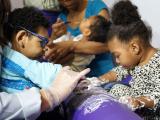Colombia's Zika virus outbreak began last October, 5 months after Brazil's, spreading quickly, and among the nearly 12,000 pregnant women thought to be infected, babies born so far to women infected during their third trimesters are showing no abnormalities, according to a study today in the New England Journal of Medicine.
Authorities, however, are closely watching outcomes for those infected earlier in their pregnancies when the virus is thought to pose a much greater risk to developing fetuses, the authors of the study noted.
The report from Colombia's Ministry of Health (MOH) and the US Centers for Disease Control and Prevention (CDC) provides the most detailed picture yet of the country's Zika outbreak, covering suspected and confirmed cases reported from Aug 9, 2015, through Apr 2, 2016. All four babies with microcephaly noted in the study were born to women with no symptoms.
Global health officials are closely watching any Zika-related birth defect patterns that might emerge from Colombia to see if the microcephaly pattern seen in Brazil repeats itself or if any new ones emerge, suggesting that other factors might be in play.
Yesterday at a World Health Organization (WHO) media briefing on Zika emergency committee deliberations, officials fielded questions about the status of Zika complications in babies born during Colombia's outbreak. They said the picture there wasn't clear yet and so far Colombia was reporting only microcephaly cases involving live births. Officials also said they've been hearing that birth defect rates in some countries might be influenced by advice to pregnant women on how to minimize the risks.
Outbreak spread fast, was expansive
Colombia's MOH started its official Zika surveillance in August 2015, though the disease was on its radar after local transmission was confirmed in Brazil in May. Colombian officials declared the start of the outbreak in early October after the first cluster of lab-confirmed cases were reported from the northern part of the country.
Zika activity spread rapidly and widely, increasing steadily through January 2016. Cases started to decline in February.
Surveillance recorded 65,726 cases as of Apr 2, including 2,485 (4%) that were confirmed by reverse-transcriptase polymerase chain reaction (RT-PCR) testing. Overall incidence in women was twice that of men, a pattern seen in other Zika-hit countries, thought to reflect factors such as increased testing in reproductive-age women because of the microcephaly threat or the role of sexual transmission.
The illness total included 11,944 in pregnant women, 1,484 (12%) of them lab confirmed.
Birth defects in 4 babies from asymptomatic moms
When the team looked at a subgroup of 1,850 pregnant women who had delivered and had complete information on the gestational week of their Zika infection, more than 90% who were infected during their third trimesters had given birth, and no infants with microcephaly or brain abnormalities were found. Pregnancies were still under way at the time of the report for women infected in their first and second trimesters.
Of the 50 microcephaly cases the MOH investigated in January through April, 4 had lab evidence of congenital Zika virus disease, and all were born to asymptomatic mothers whose illnesses weren't part of the surveillance system. All tested positive for Zika virus on RT-PCR assay; 1 had abnormal brain findings on ultrasound and 3 had abnormal hearing results.
So far 26 suspected microcephaly cases are still under investigation, and 20 were said to result from other causes.
The researchers concluded that, based on Colombian surveillance, maternal infections with Zika virus during the third trimester don't appear to be linked to structural abnormalities in babies, though monitoring of the country's infected pregnant women is ongoing.
They added that health providers are poised to play a key role in educating patients about the importance of mosquito bite prevention to the curb the risk of all mosquito-borne diseases and that the counseling is especially important for women, notably those at risk for unintended pregnancies. According to the report, roughly half of pregnancies in Colombia are unplanned, 61% of reproductive-age women use contraception, and less than half of younger sexually active women report condom use during sex.
Questions abound on long-term impact
Michael Osterholm, PhD, MPH, director of the Center for Infectious Disease Research and Policy (CIDRAP) at the University of Minnesota, said the study is well done and provides a useful epidemiologic picture of where Colombia is with its Zika outbreak. CIDRAP is the publisher of CIDRAP News.
He said the lack of apparent structural findings, mainly microcephaly, in women infected during the third trimester is in line with what's expected. However, he urged careful interpretation of findings. "Other neurological abnormalities might not immediately show up at birth," he said.
Earlier this month the WHO said mounting reports are linking Zika virus to a wider range of birth defects than previously thought. The agency added that the virus's effects warrant its own congenital syndrome and that efforts are under way to define it. The WHO also said babies born with Zika complications may face a host of still-known complications—even in some with normal head circumference.
The WHO alluded to unpublished reports of other problems in Zika-infected babies, such as genitourinary, cardiac, and digestive system abnormalities.
See also:
Jun 15 N Engl J Med study
Jun 14 CIDRAP News story "WHO panel: Risk of Zika spread from Olympics very low"
Jun 3 CIDRAP News story "WHO: Array of Zika birth defects equals new syndrome"




















